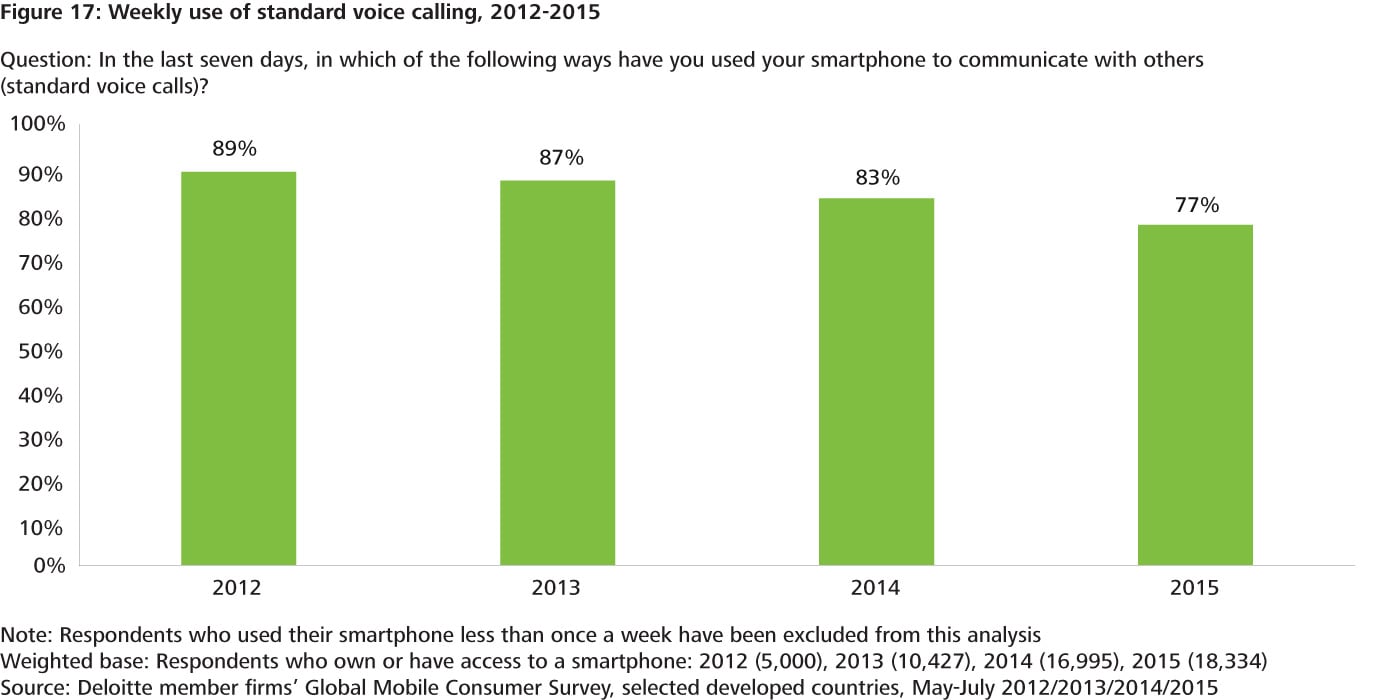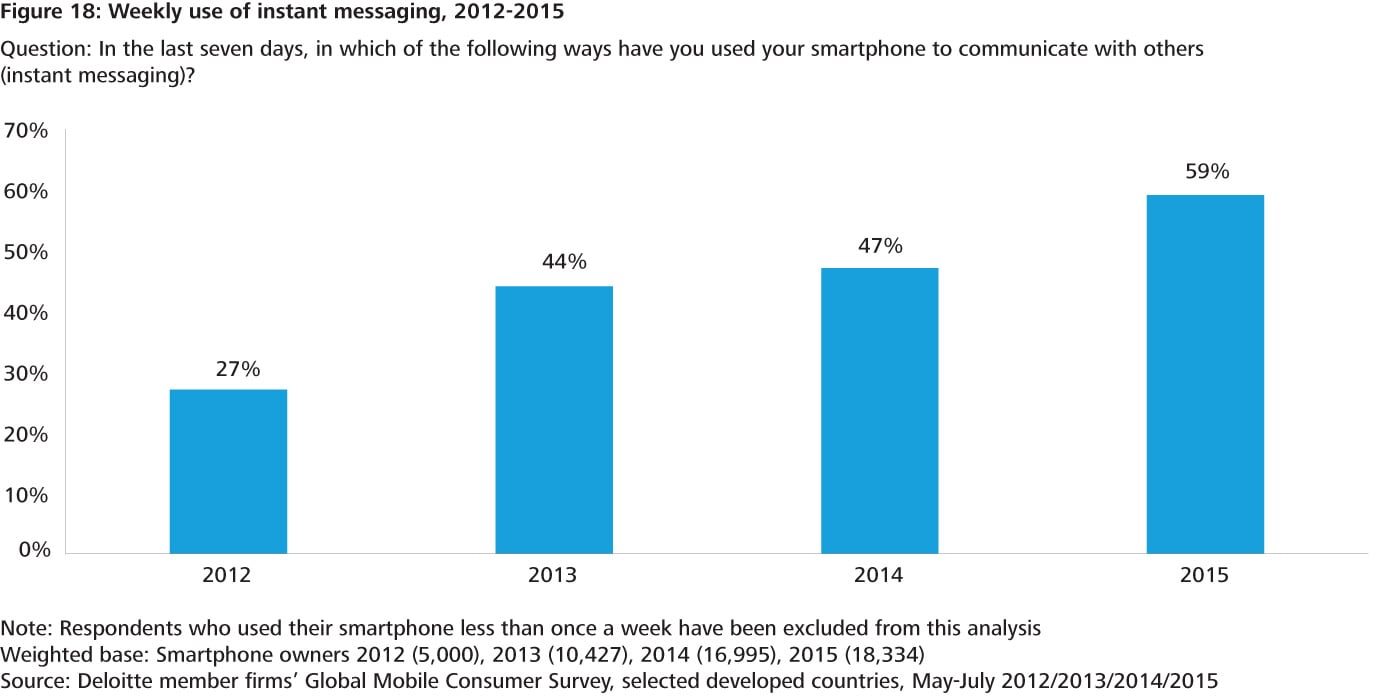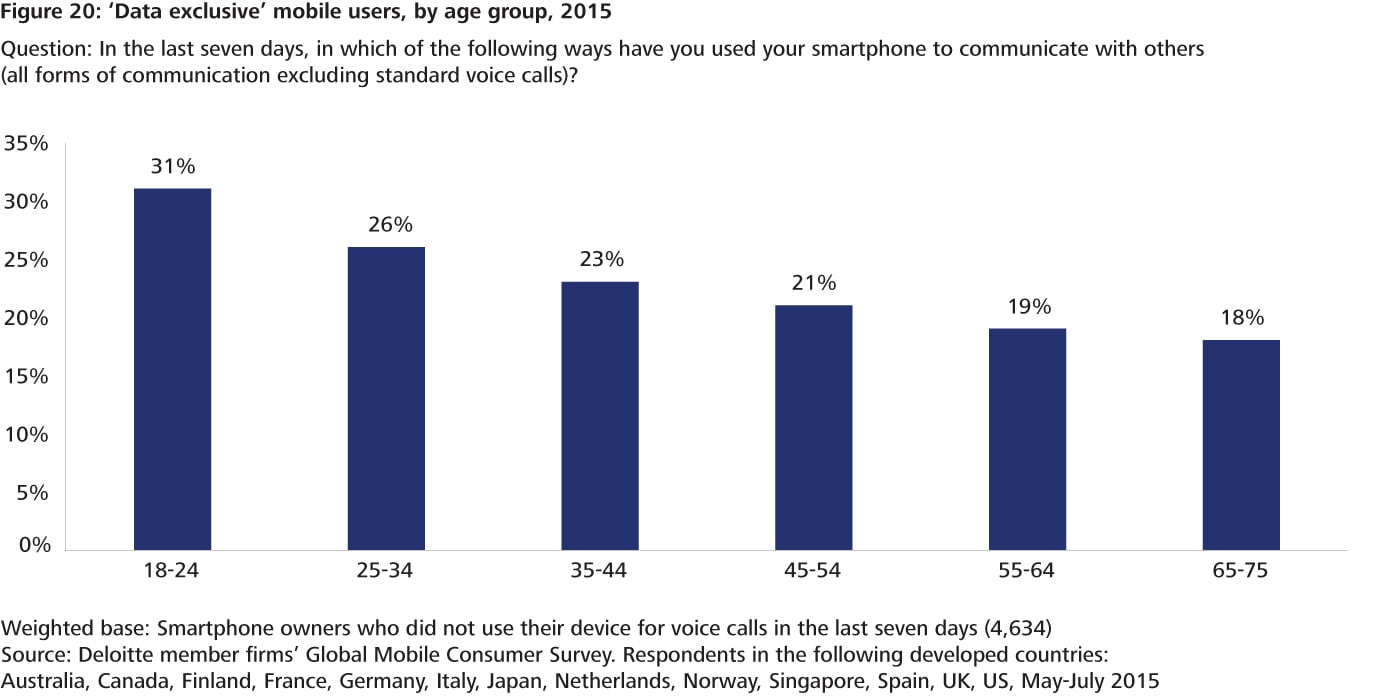Predictions

The rise of the data exclusive
TMT Predictions 2016
Executive summary
Deloitte Global predicts that in 2016, 26 percent of smartphone users in developed markets will not make any traditional phone calls in a given week. We call these individuals ‘data exclusives’. They have not stopped communicating, but are rather replacing traditional voice calls with a combination of messaging (including SMS), voice and video services delivered ‘over the top’. The data exclusive contingent was 22 percent of all smartphone users in 2015, and 11 percent in 2012 (see Figure 1).
In recent years there have been two contrasting trends with voice. First, mobile voice volumes as measured in minutes have increased by 20 percent between 2012 and 2015, likely because of the increased affordability of voice minutes, the rising take-up of unlimited voice packages, an increase in voice minute allowances and an ongoing substitution of fixed to mobile calling. Second, most smartphone owners’ usage patterns have become more data-intensive, with the proportion of time spent on non-voice activity increasing considerably; in some markets, such as the UK and the US it has reportedly trebled.
What may be happening is a polarization in the usage of voice on mobile: some users are increasing their voice call volumes; at the other end of the scale a growing proportion are not using voice at all.
A key catalyst for the fall in the proportion of people making voice calls on their smartphones has likely been the proliferation of options to communicate without speaking. While voice calls have been declining, various forms of data communication have become more popular. As of mid-2015, the most popular data service was text messaging, with 60 percent usage, closely followed by instant messaging, email and social networks. Note that it is not just private conversations that are being usurped. An app can replace the calls we would have formerly made to order a take-away, request a taxi, book an appointment or make a bank transfer.
The age group with the largest proportion of data exclusives as of mid-2015 was 18-24 year-olds, 31 percent of whom (in developed countries) reported not making phone calls on a weekly basis, compared to the average for adults of 22 percent. In 2016 and beyond the proportion of data exclusive 18-24 year-old users may rise further still, given that upcoming members of this cohort are likely very accustomed to messaging. Their first communications device as young children may have been a touch-screen MP3 player or a WiFi tablet, which can readily be used for messaging but lacks a cellular modem for traditional voice calls. By the time a teen grows up and has the funds to pay for a regular mobile phone package that includes voice calls, he or she may regard messaging as the default mode of communication and may instinctively avoid making voice calls.
The original premise of the smartphone was that it would enable voice and data communications via the one device. However, in the last decade the data capabilities of smartphones have steadily ratcheted up, in the form of bigger screens, faster connectivity, more powerful processors, superior cameras and improved graphics capabilities – all of which contribute to the trend of people choosing data communications instead of traditional voice calls.
1 For a complete list of references and footnotes, please download the full PDF version of the TMT Predictions 2016 report.
Deloitte Global predicts that in 2016, 26 percent of smartphone users in developed markets will not make any traditional phone calls in a given week. We call these individuals ‘data exclusives’. They have not stopped communicating, but are rather substituting traditional voice calls for a combination of messaging (including SMS), voice and video services delivered ‘over the top’. The data exclusive contingent was 22 percent of all smartphone users in 2015, and 11 percent in 2012 (see Figure 1).
In recent years there have been two contrasting trends with voice. First, mobile voice volumes as measured in minutes have increased by 20 percent between 2012 and 2015, likely because of the increased affordability of voice minutes, the rising take-up of unlimited voice packages, an increase in voice minute allowances and an ongoing substitution of fixed to mobile calling.
Second, most smartphone owners’ usage patterns have become more data-intensive, with the proportion of time spent on non-voice activity increasing considerably; in some markets, such as the UK and the US it has reportedly trebled.
What may be happening is a polarization in the usage of voice on mobile: some users are increasing their voice call volumes; at the other end of the scale a growing proportion are not using voice at all.
Question: In the last seven days, in which of the following ways have you used your smartphone to communicate with others (standard voice calls)?

Note: Respondents who used their smartphone less than once a week have been excluded from this analysis
Weighted base: Respondents who own or have access to a smartphone: 2012 (5,000), 2013 (10,427), 2014 (16,995), 2015 (18,334)
Source: Deloitte member firms’ Global Mobile Consumer Survey, selected developed countries, May-July 2012/2013/2014/2015
A key catalyst for the fall in the proportion of people making voice calls on their smartphones has likely been the proliferation of options to communicate without speaking. Phone conversations with friends and family, for example, have been supplanted to an extent by social networks, which offer multiple enhancements to a standard conversation, such as the ability to broadcast to friends and family, incorporate emoji and append photos, videos and hyperlinks. Social networks, IM (instant messaging), email and other forms of messaging also offer control over when to respond: they are asynchronous, while voice conversation obliges a real-time response.
It is not just private conversations that are being usurped. An app can replace the calls we would have formerly made to order a take-away, request a taxi, book an appointment or make a bank transfer.
Over the same period of decline in voice calls, most forms of data communication, such as IM , social networks and even the now ‘old school’ email, have become more popular.
IM has seen the most rapid uptake among consumers since 2012, with the proportion of adults using IM more than doubling from 27 percent in 2012 to 59 percent in 2015 (Figure 2), and volumes escalating from 7 trillion in 2012 to 43 trillion in 2015.
Question: In the last seven days, in which of the following ways have you used your smartphone to communicate with others (instant messaging)?

Note: Respondents who used their smartphone less than once a week have been excluded from this analysis
Weighted base: Smartphone owners 2012 (5,000), 2013 (10,427), 2014 (16,995), 2015 (18,334)
Source: Deloitte member firms’ Global Mobile Consumer Survey, selected developed countries, May-July 2012/2013/2014/2015
Interestingly the text message, a relatively cheap and simple form of data communication, remains widely used among those not making voice calls. As of mid-2015, the most popular data service used was text messaging, with 60 percent usage, closely followed by instant messaging, email and social networks (see Figure 3).
Question: In the last seven days, in which of the following ways have you used your smartphone to communicate with others (all forms of communication excluding standard voice calls)?

Weighted base: Smartphone owners who did not used their device to make voice calls in the last seven days (4,634)
Source: Deloitte member firms’ Global Mobile Consumer Survey. Respondents in the following developed countries: Australia, Canada, Finland, France, Germany, Italy, Japan, Netherlands, Norway, Singapore, Spain, UK, US, May-July 2015
The age group with the largest proportion of data exclusives as of mid-2015 was 18-24 year-olds, 31 percent of whom (in developed countries) reported not making phone calls on a weekly basis, compared to the average for adults of 22 percent.
Figure 4 shows the proportion of data exclusive users by age group.
Question: In the last seven days, in which of the following ways have you used your smartphone to communicate with others (all forms of communication excluding standard voice calls)?

Weighted base: Smartphone owners who did not used their device for voice calls in the last seven days (4,634)
Source: Deloitte member firms’ Global Mobile Consumer Survey. Respondents in the following developed countries: Australia, Canada, Finland, France, Germany, Italy, Japan, Netherlands, Norway, Singapore, Spain, UK, US, May-July 2015
In 2016 and beyond the proportion of data exclusive 18-24 year-old users may rise further still, given that upcoming members of this cohort are likely very accustomed to messaging. Their first communications device as young children may have been a touch-screen MP3 player or a WiFi tablet, which can readily be used for messaging, apps and other types of data functionality, but lacks a cellular modem, and therefore has no capability to make traditional voice calls.
As children progress to their first smartphone, they may not be provided with a voice and data package in order to control costs, and they may use this device exclusively over WiFi, with only occasional use of OTT voice technology. By the time a teen has the funds to pay for a regular mobile phone package that includes voice calls, he or she may regard messaging as the default mode of communication and they may instinctively avoid making voice calls.
Bottom line
The original premise of the smartphone was that it would enable voice and data communications via the one device. In the last decade the data capabilities of smartphones have steadily ratcheted up, in the form of bigger screens, faster connectivity, more powerful processors, superior cameras and improved graphics capabilities.
The most obvious implication for carriers is that offering monthly plans with very large or unlimited voice minutes may not be equally attractive for all customers. If 20 percent are talking fewer than 100 minutes per month, they will likely respond only to other inducements, perhaps ‘all you can app’ messaging plans or simply better data networks. Depending on the alternative to cellular voice, increased use of messaging, especially with pictures or video, may help drive consumers to bigger data plans, enhancing average revenue per user (ARPU).
A decline in voice call traffic could also enable carriers to reduce the quantity of spectrum assigned to voice, and make this available for data.
Smartphone vendors should consider whether a decline in voice usage may encourage a rise in sales of large smartphones (also known as phablets). One of the barriers to large smartphone adoption had been the obtrusiveness of the device when making calls, but if fewer calls are being made, larger screens are arguably preferable for messaging applications.
Any entity communicating with the public should consider how best to adapt to these trends. Government should determine whether to focus on app-based communications rather than call centers; fast food purveyors might want to focus on improving app-based or web-based ordering, on the assumption that customers would rather type than talk when placing orders.

@DeloitteTMT